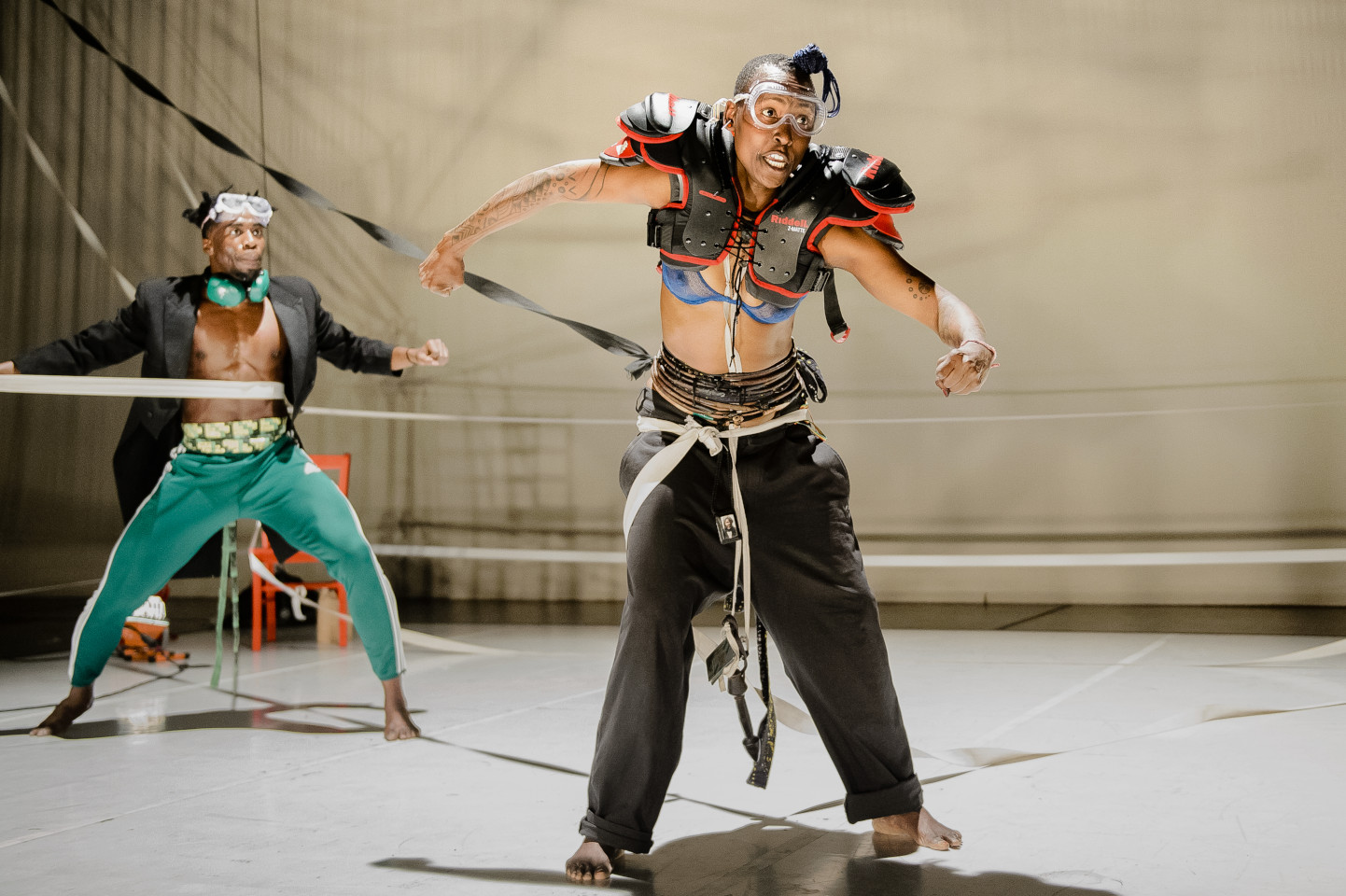In part 2 of their Tanz im August Talkback, Springback’s Berlin Three – Annette van Zwoll, David Pallant and Evgeny Borisenko – reflect on Nora Chipaumire’s portrait of myself as my father and Noé Soulier’s The Waves.

article

In part 2 of their Tanz im August Talkback, Springback’s Berlin Three – Annette van Zwoll, David Pallant and Evgeny Borisenko – reflect on Nora Chipaumire’s portrait of myself as my father and Noé Soulier’s The Waves.
Inside a roped-off boxing ring, Nora Chipaumire stands tethered to another performer, while a third plays the hype man, bounding around outside the perimeter. The performers’ voices provide a soundtrack of narration and commentary as they encourage, insult and roar at each other and us. Outbursts of movement, when they come, are frantic, as the three performers slam their feet against the floor, spines curling and hips snapping. portrait of myself as my father explores the point where colonialism, blackness, and masculinity meet, with confrontational playfulness and a visceral intelligence.
David: Racial politics and the black experience are so integral to this work that I think it’s important to acknowledge the lens we view this piece through, as three white Europeans, and the effect that has. Because Chipaumire is dealing with with huge topics, like race, gender, decolonisation…
Evgeny: And she’s speaking about decolonising herself, letting go of the colonial past brought to her through the performer we assume represented her father, to whom she’s literally tied throughout the piece.
Annette: The image of her carrying her ‘father’, was very telling. Through her history, through her father’s history, she lays bare the colonial past and the ways it lingers; the ties that link them are white, and they must exist in relation to that whiteness. Her father represents the limitations imposed on black men: the options seem to be ‘fight, run, fuck or die’, and the limitations imposed on him are still in her body, as all of our histories are there somewhere in our bodies and brains.
David and I found the form unconventional, and at times difficult to grab on to, but you didn’t, right Evgeny?
Evgeny: Usually when I see a piece I try to find yardsticks, or markers. In this case they were formal elements like the stage design suspended from the lighting rig, the two performers tied together, and the ‘animalistic’ movement of her ‘father’.
Annette: This animalistic movement touched on stereotypes around black people, but there was also a sense that the performers owned or were empowered by it. There was so much layered imagery that it sometimes made the meaning ‘ungrabbable’ for me – when I thought I understood it, it shifted again.
David: I was made very aware of my own lack of tools to fully understand the piece, through the difference of my experience, through my lack of knowledge of non-Western traditions and forms of expression. It was a challenge at times, and I think the piece was unapologetic in the sense that it didn’t try to translate things for us. The onus was placed on us to do that work, which made complete sense considering the overall themes of the piece.
Evgeny: I found the first part of the piece quite overstretched, it used mostly the same rules. But this moment when she was attacking her ‘father’, pushing him into the corner of the boxing ring, telling him to ‘Fight!’, it felt as the piece had become dramatic when it wasn’t supposed to. There was something terribly raw and true in that short scene. And when she says ‘You’d better run’, and then they all start to run and pull apart the boxing ring until it fell down, it felt so very cathartic.
Annette: This emotional ending, when she said ‘This is a manifesto about me, and about my father’, it was a moment of catharsis.
Evgeny: I found that a bit over the top probably, for me it was already personal and crystal-clear from the outset. It felt almost too Hollywood, like it must end with something dramatic.
David: I saw the ending as anchoring the piece back into reality. Very nuanced and complex issues were presented in very nuanced and complex ways – portrait didn’t give any easy answers, neither for the performers examining their identity or us, in the audience, with our white guilt. But it’s our nature to look for resolution or answers, and perhaps this ‘dramatic’ ending is Chipaumire stating the manifesto that helps her to continue to deal with all these complex issues.


Six dancers calmly advance onstage to an irregular rhythm of a percussion duo, only to explode into a series of frenetic jumps, aborted throws, leg kicks and sudden dashes. Cut with intense low-to-the-ground duos and flurrying solos, the swirling group dances seek to embody unassuming desires, long-vanished affects and overwrought angst – all led by jagged percussion composition. The performance is punctuated by moving excerpts of Virginia Woolf’s The Waves, read by the performers. Bodies continue to ricochet and scatter, arms cut the air, intricate solos irrupt rigorous group patterns, building the show to its abrupt finale in an assuredly wavy fashion.
Evgeny: Let’s start with some personal impressions. It was a very moving piece for me, although cold and rigorous. Hard to get into, but surprisingly soothing once inside. What did you feel?
Annette: I’m on the same level as Evgeny, and I think the codes of the world they’ve created were quite clear. It was very gestural and rhythmical. It was a proposal that you could step into or not. It didn’t reach me on a very emotional level but I felt comfortable sharing the space with them.
David: I agree that there was a coldness and detachment, and that instead of trying to grab your attention, the piece just created a comfortable environment. But I didn’t manage to connect to it on any level. It felt very old-fashioned, in terms of form, style and aesthetics. Movement phrases were repeated, cut up and pasted together in different ways: unison, solos, duets. They’re pretty basic choreographic tools and, instead of being questioned or subverted, or serving as a jumping-off point, they were the substance of the piece.
Evgeny: True, there was a certain lack of ambition. What’s happening inside this choreographic scaffolding? Another counter-example might be Anne Teresa De Keersmaeker, with her mathematical approach to the choreographic structure, never questioned but always present.
Annette: Her structural approach has always been clearly communicated through movement. Here it was much less transparent.
David: Exactly. De Keersmaeker takes it to the nth degree, but this was sort of in-between: it was well-structured, but it neither went beyond the structure, nor pushed the structure to its limits.
Evgeny: I also found the first duet so refreshingly beautiful with its odd limb holds; was it a love story or a childhood memory? And later, another scene with a dancer approaching other performers one by one and staring into their eyes. These quiet moments set off the otherwise very rhythmical group pace and become all the more startling, with dancers being so aware of each other.
David: I agree, the attention paid to the dancer’s gaze made the piece very subtle. There was a very clear relation to the audience, to the space around them, to each other, to the imaginary objects. In that sense the dancers’ intentions were very clear.
Evgeny: Do you remember this excerpt from Virginia Woolf’s The Waves recited twice onstage: ‘I begin to long for some little language such as lovers use, broken words, inarticulate words’? At that moment I grew more attentive to the clumsiness of some stumbling dance patterns. This broken language described by Woolf was very well performed.
David: For me, The Waves seemed like an odd choice. There’s such rawness and urgency to Woolf’s language which was completely absent from the performance. And with the words spoken neutrally, by a dancer standing still or making some very clear, contained movements, I missed the sensuality; it fell flat. What I craved, in the end, was a melody, some sense of poetry.
Annette: And more of an outburst! ●
Read part 1 of Tanz im August talkabout to find out what the Berlin Three thought about Bruno Beltrão’s Inoah and Silvia Gribaudi’s R. OSA
portrait of myself as my father
Artistic Direction, Concept, Choreography: Nora Chipaumire
Original Music & Sound Score: Philip White
Extra Sound Score & Text: Nora Chipaumire
With: Nora Chipaumire, Pape Ibrahima Ndiaye a.k.a. Kaolack, Shamar Watt
Lighting & Costume Design: Nora Chipaumire
Technical Direction & Stage Management: Philip White
For more information on tour dates, see Nora Chipaurmire’s calendar.
The Waves
Choreography: Noé Soulier
With Stephanie Amurao, Lucas Bassereau, Meleat Frederikson, Yumiko Funaya, Anna Massoni and Nans Pierson
Music: Noé Soulier, Tom De Cock and Gerrit Nulens
Interpretation: Ensemble Ictus (Tom De Cock and Gerrit Nulens, percussions)
Light design: Victor Burel
Production: ND Productions
The Waves is on tour through to May 2019: Porto (Portugal), Paris, Toulouse, Lille and Orléans (France), Brussels (Belgium), Freiburg (Germany). See noesoulier.com/calendar for details.

review, article